Abstract
1. The hyperalgesic activities in rats of bradykinin, carrageenin and lipopolysaccharide (LPS) were investigated in a model of mechanical hyperalgesia. 2. Bradykinin and carrageenin evoked dose-dependent hyperalgesia with maximum responses of similar magnitude to responses to LPS (1 and 5 micrograms). 3. Hoe 140, an antagonist of BK2 receptors, inhibited in a dose-dependent manner hyperalgesic responses to bradykinin, carrageenin and LPS (1 microgram) but not responses to LPS (5 micrograms), prostaglandin E2, dopamine, tumour necrosis factor alpha (TNF alpha), IL-1, IL-6 and IL-8. 4. Responses to bradykinin and LPS (1 and 5 micrograms) were inhibited by the cyclo-oxygenase inhibitor, indomethacin and by the beta-adrenoceptor antagonist, atenolol. The effects of indomethacin and atenolol were additive: their combination abolished responses to bradykinin and LPS (1 microgram) and markedly attenuated the response to LPS (5 micrograms). 5. Antiserum neutralizing endogenous TNF alpha abolished the response to bradykinin whereas antisera neutralizing endogenous IL-1 beta, IL-6 and IL-8 each partially inhibited the response. The combination of antisera neutralizing endogenous IL-1 beta+IL-8 or IL-6+IL-8 abolished the response to bradykinin. 6. Antisera neutralizing endogenous TNF alpha, IL-1 beta, IL-6 and IL-8 each partially inhibited responses to LPS (1 and 5 micrograms). Increasing the dose of antiserum to TNF alpha or giving a combination of antisera to IL-1 beta+IL-8 or IL-6+IL-8 further inhibited responses to LPS (1 and 5 micrograms). 7. These data show that bradykinin can initiate the cascade of cytokine release that mediates hyperalgesic responses to carrageenin and endotoxin (1 microgram).(ABSTRACT TRUNCATED AT 250 WORDS)
Full text
PDF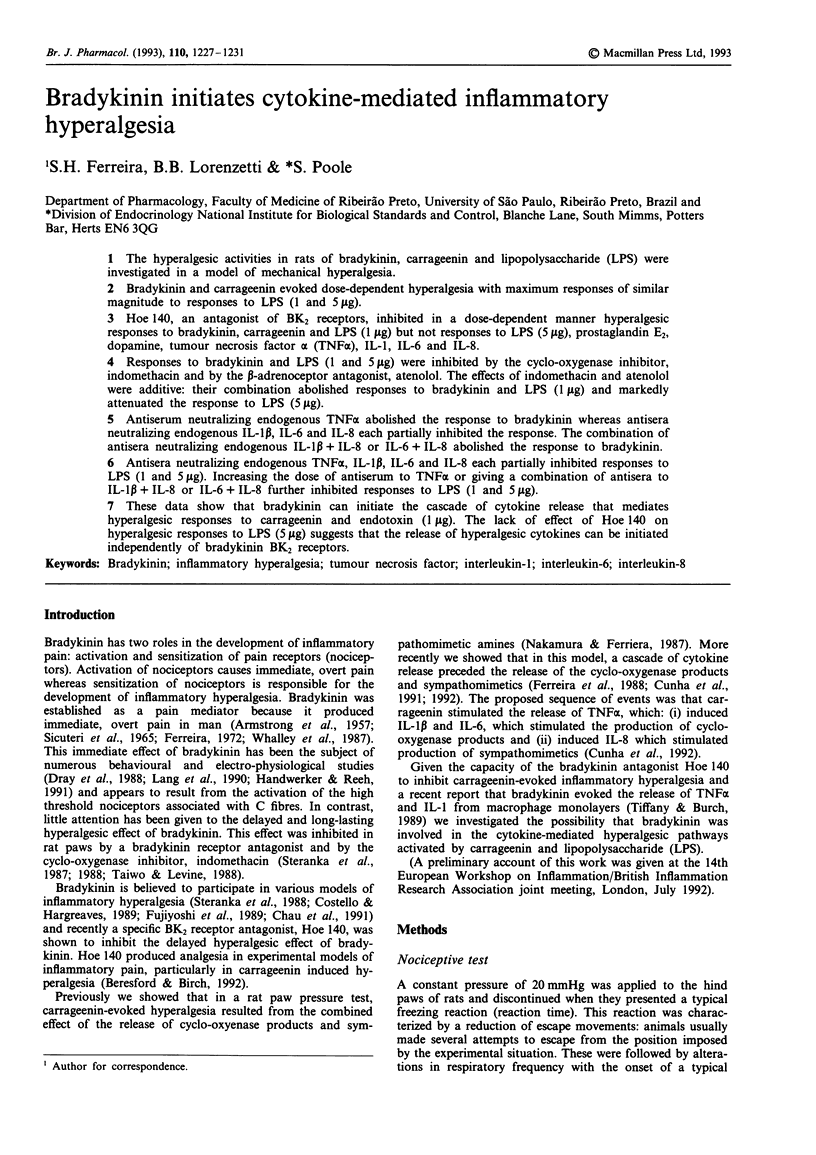
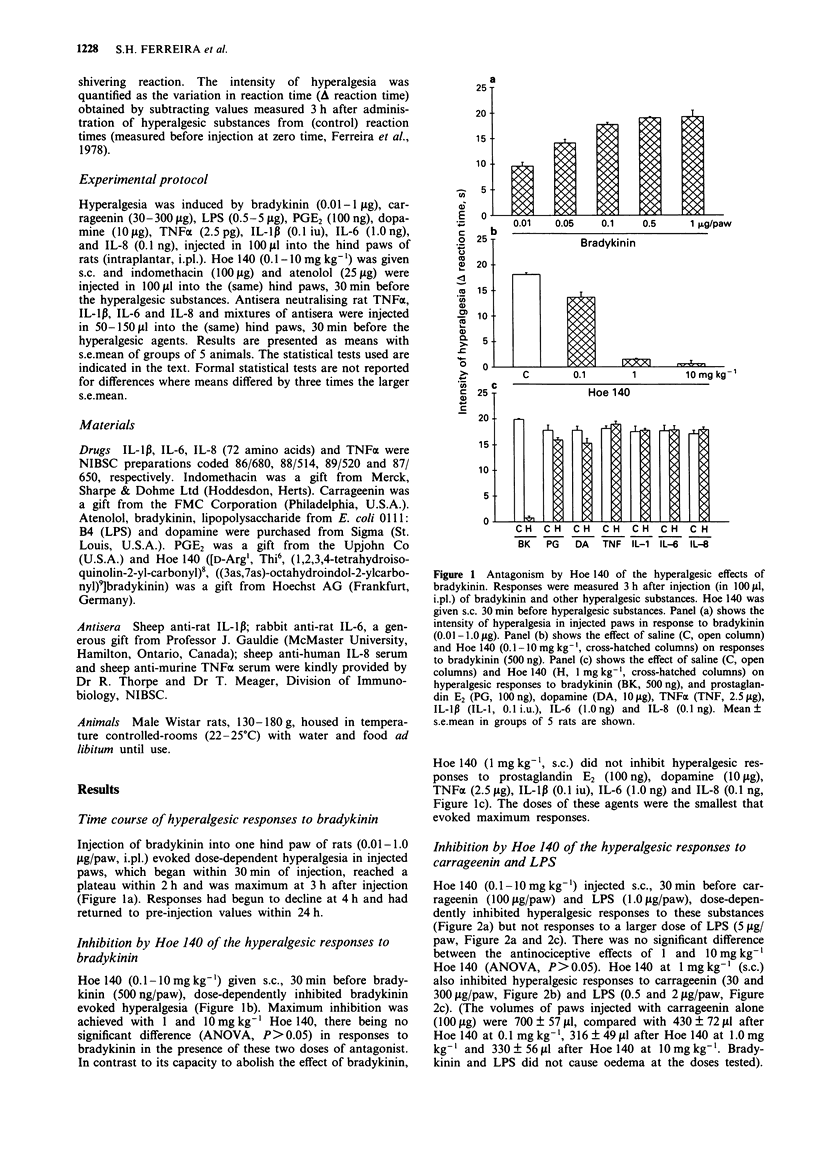
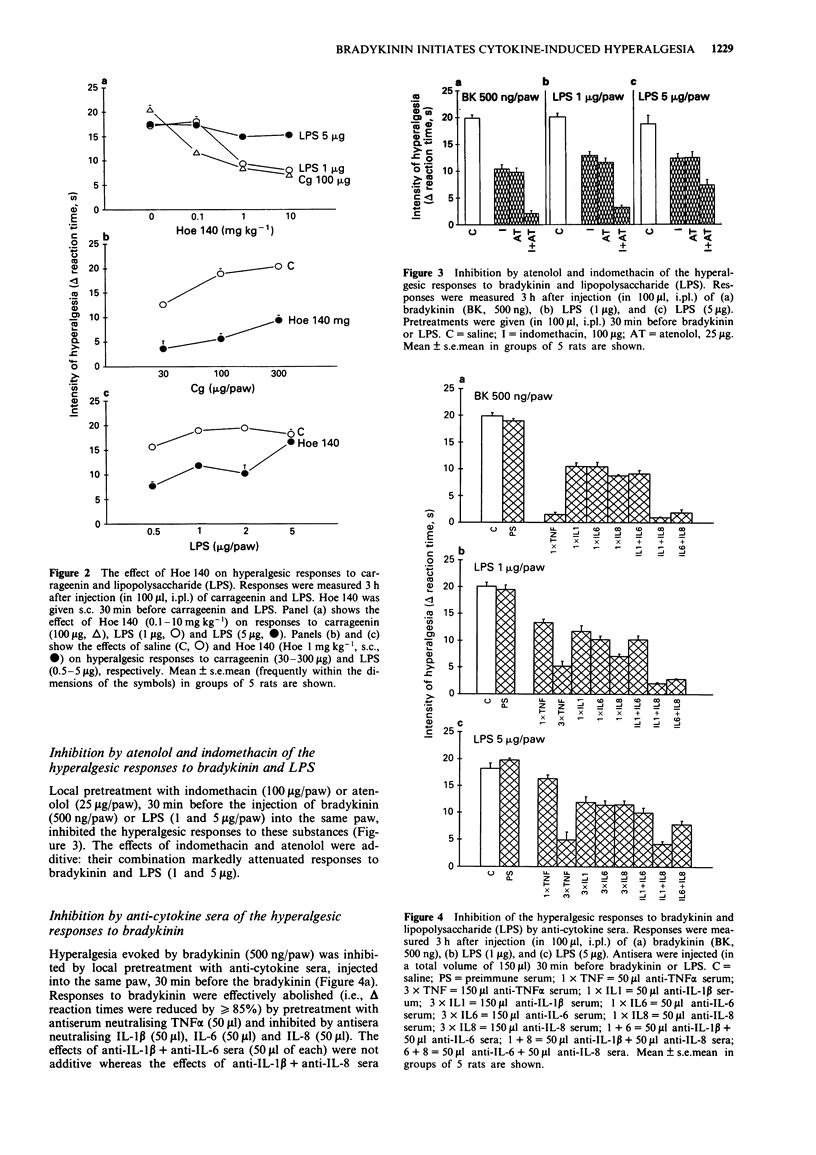
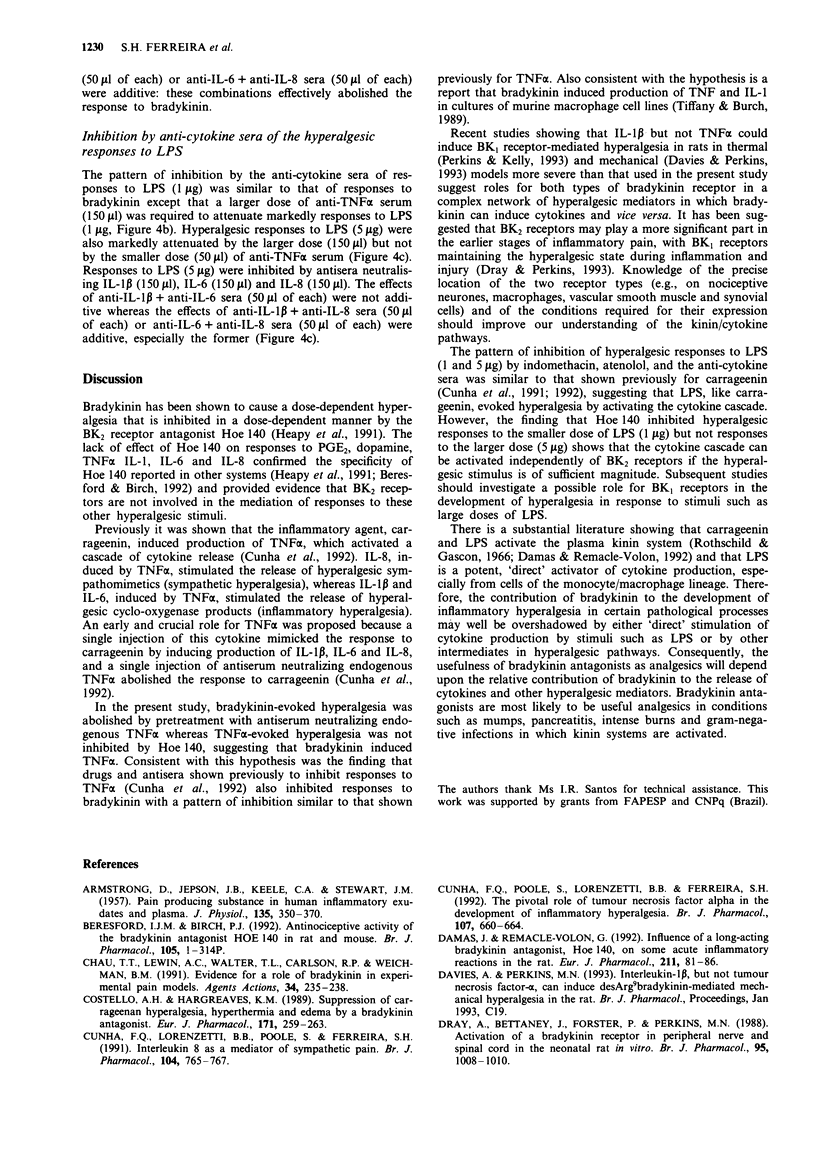
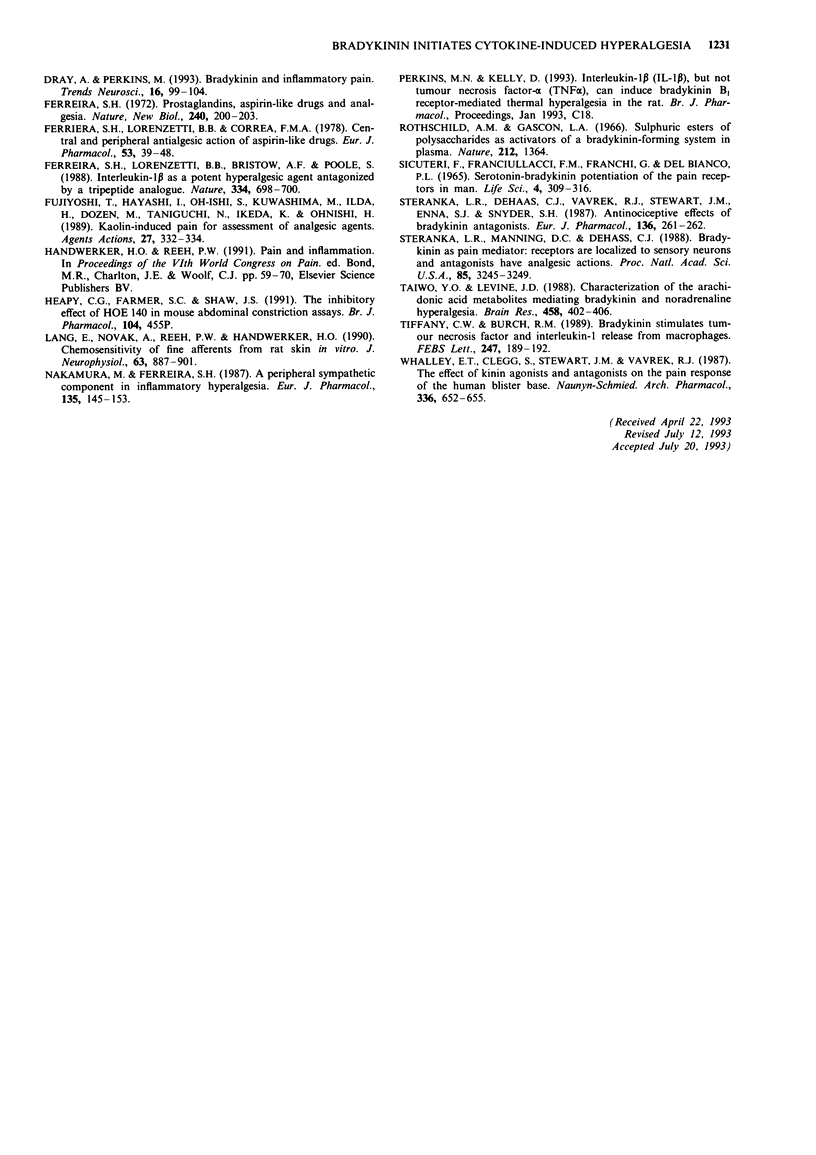
Selected References
These references are in PubMed. This may not be the complete list of references from this article.
- ARMSTRONG D., JEPSON J. B., KEELE C. A., STEWART J. W. Pain-producing substance in human inflammatory exudates and plasma. J Physiol. 1957 Feb 15;135(2):350–370. doi: 10.1113/jphysiol.1957.sp005715. [DOI] [PMC free article] [PubMed] [Google Scholar]
- Chau T. T., Lewin A. C., Walter T. L., Carlson R. P., Weichman B. M. Evidence for a role of bradykinin in experimental pain models. Agents Actions. 1991 Sep;34(1-2):235–238. doi: 10.1007/BF01993290. [DOI] [PubMed] [Google Scholar]
- Costello A. H., Hargreaves K. M. Suppression of carrageenan-induced hyperalgesia, hyperthermia and edema by a bradykinin antagonist. Eur J Pharmacol. 1989 Nov 21;171(2-3):259–263. doi: 10.1016/0014-2999(89)90118-0. [DOI] [PubMed] [Google Scholar]
- Cunha F. Q., Lorenzetti B. B., Poole S., Ferreira S. H. Interleukin-8 as a mediator of sympathetic pain. Br J Pharmacol. 1991 Nov;104(3):765–767. doi: 10.1111/j.1476-5381.1991.tb12502.x. [DOI] [PMC free article] [PubMed] [Google Scholar]
- Cunha F. Q., Poole S., Lorenzetti B. B., Ferreira S. H. The pivotal role of tumour necrosis factor alpha in the development of inflammatory hyperalgesia. Br J Pharmacol. 1992 Nov;107(3):660–664. doi: 10.1111/j.1476-5381.1992.tb14503.x. [DOI] [PMC free article] [PubMed] [Google Scholar]
- Damas J., Remacle-Volon G. Influence of a long-acting bradykinin antagonist, Hoe 140, on some acute inflammatory reactions in the rat. Eur J Pharmacol. 1992 Jan 28;211(1):81–86. doi: 10.1016/0014-2999(92)90266-7. [DOI] [PubMed] [Google Scholar]
- Dray A., Bettaney J., Forster P., Perkins M. N. Activation of a bradykinin receptor in peripheral nerve and spinal cord in the neonatal rat in vitro. Br J Pharmacol. 1988 Dec;95(4):1008–1010. doi: 10.1111/j.1476-5381.1988.tb11732.x. [DOI] [PMC free article] [PubMed] [Google Scholar]
- Dray A., Perkins M. Bradykinin and inflammatory pain. Trends Neurosci. 1993 Mar;16(3):99–104. doi: 10.1016/0166-2236(93)90133-7. [DOI] [PubMed] [Google Scholar]
- Ferreira S. H., Lorenzetti B. B., Bristow A. F., Poole S. Interleukin-1 beta as a potent hyperalgesic agent antagonized by a tripeptide analogue. Nature. 1988 Aug 25;334(6184):698–700. doi: 10.1038/334698a0. [DOI] [PubMed] [Google Scholar]
- Ferreira S. H., Lorenzetti B. B., Corrêa F. M. Central and peripheral antialgesic action of aspirin-like drugs. Eur J Pharmacol. 1978 Dec 15;53(1):39–48. doi: 10.1016/0014-2999(78)90265-0. [DOI] [PubMed] [Google Scholar]
- Ferreira S. H. Prostaglandins, aspirin-like drugs and analgesia. Nat New Biol. 1972 Dec 13;240(102):200–203. doi: 10.1038/newbio240200a0. [DOI] [PubMed] [Google Scholar]
- Fujiyoshi T., Hayashi I., Ohishi S., Kuwashima M., Iida H., Dozen M., Taniguchi N., Ikeda K., Ohnishi H. Kaolin-induced writhing in mice, a new model of possible bradykinin-induced pain for assessment of analgesic agents. Agents Actions. 1989 Jun;27(3-4):332–334. doi: 10.1007/BF01972814. [DOI] [PubMed] [Google Scholar]
- Lang E., Novak A., Reeh P. W., Handwerker H. O. Chemosensitivity of fine afferents from rat skin in vitro. J Neurophysiol. 1990 Apr;63(4):887–901. doi: 10.1152/jn.1990.63.4.887. [DOI] [PubMed] [Google Scholar]
- Nakamura M., Ferreira S. H. A peripheral sympathetic component in inflammatory hyperalgesia. Eur J Pharmacol. 1987 Mar 17;135(2):145–153. doi: 10.1016/0014-2999(87)90606-6. [DOI] [PubMed] [Google Scholar]
- Rothschild A. M., Gascon L. A. Sulphuric esters of polysaccharides as activators of a bradykinin-forming system in plasma. Nature. 1966 Dec 17;212(5068):1364–1364. doi: 10.1038/2121364a0. [DOI] [PubMed] [Google Scholar]
- SICUTERI F., FRANCIULLACCI M., FRANCHI G., DELBIANCO P. L. SEROTONIN--BRADYKININ POTENTIATION ON THE PAIN RECEPTORS IN MAN. Life Sci. 1965 Feb;4:309–316. doi: 10.1016/0024-3205(65)90147-5. [DOI] [PubMed] [Google Scholar]
- Steranka L. R., DeHaas C. J., Vavrek R. J., Stewart J. M., Enna S. J., Snyder S. H. Antinociceptive effects of bradykinin antagonists. Eur J Pharmacol. 1987 Apr 14;136(2):261–262. doi: 10.1016/0014-2999(87)90723-0. [DOI] [PubMed] [Google Scholar]
- Steranka L. R., Manning D. C., DeHaas C. J., Ferkany J. W., Borosky S. A., Connor J. R., Vavrek R. J., Stewart J. M., Snyder S. H. Bradykinin as a pain mediator: receptors are localized to sensory neurons, and antagonists have analgesic actions. Proc Natl Acad Sci U S A. 1988 May;85(9):3245–3249. doi: 10.1073/pnas.85.9.3245. [DOI] [PMC free article] [PubMed] [Google Scholar]
- Taiwo Y. O., Levine J. D. Characterization of the arachidonic acid metabolites mediating bradykinin and noradrenaline hyperalgesia. Brain Res. 1988 Aug 23;458(2):402–406. doi: 10.1016/0006-8993(88)90487-8. [DOI] [PubMed] [Google Scholar]
- Tiffany C. W., Burch R. M. Bradykinin stimulates tumor necrosis factor and interleukin-1 release from macrophages. FEBS Lett. 1989 Apr 24;247(2):189–192. doi: 10.1016/0014-5793(89)81331-6. [DOI] [PubMed] [Google Scholar]
- Whalley E. T., Clegg S., Stewart J. M., Vavrek R. J. The effect of kinin agonists and antagonists on the pain response of the human blister base. Naunyn Schmiedebergs Arch Pharmacol. 1987 Dec;336(6):652–655. doi: 10.1007/BF00165756. [DOI] [PubMed] [Google Scholar]


